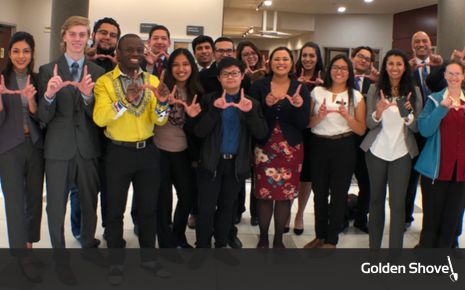101 Tips & Tricks to Market Your Community Better

24 Jan 2023
News, Marketing
101 Professional Marketing Tips & Tricks for Economic Developers
Marketing is a crucial part of economic development. However, many economic developers do not have any professional training in the marketing industry. That’s where help from an agency like Golden Shovel comes in.
Audrey Anderson, Director of Marketing & Communications for Golden Shovel Agency, has earned a dual certification as a Certified Digital Marketing Professional (CDMP) from the Digital Marketing Institute and a Professional Certified Marketer from the American Marketing Association. Throughout her training, she collected the following notes to be shared with economic developers. We encourage you to apply these tips and tricks to your marketing strategy.
Learn more about the Digital Marketing Institute here.
Learn more about the American Marketing Association here.
What Is Digital Marketing? Where Should I Start?
1. Utilize inbound marketing - this involves typing to pull your audience towards your content/brand/service and attracting those who are already interested in your product/service so that they seek you out and engage.
2. Earn media attention - earned media is free publicity generated by consumers, PR, influences, and people who speak about and share content related to you.
3. Use SMART goals when developing marketing objectives - SMART goals are Specific, Measurable, Achievable, Relevant, and Time-Bound.
4. Listen to your audience - you can gather information about what matters to your target audience through social media platforms, secondary research (free reports providing data research), surveys, and behavior analytics.
5. Do industry trend research - this enables a company to develop a competitive strategy that defends against competitive forces or includes them in its favor. You can find industry trends through social media, market research reports, search analytics, and academics.
6. Connect with consumers at all stages of the buyer journey -
- Awareness - consumer becomes aware of a problem they want to solve and your product as a potential solution
- Interest - consumer is looking for options to solve their problem
- Consideration - consumer knows about your brand and thinks it is a good fit
- Conversion - consumer is ready to take action
- Retention - consumer has used product/service and is satisfied; now, you should provide added value and create a relationship
7. Utilize 360 marketing campaigns - these cover the entire buying cycle; tap into each audience’s point of contact; optimize for scale relevance; and provide a complete marketing experience.
8. Use the inbound channels that are available to you - inbound channels include paid search (PPC), SEO, content marketing, email marketing, web analytics, and digital strategy.
9. Utilize the seven-step framework for managing projects -
- Identify the project or campaign
- Write a project brief (include the project summary, some basic details, the goal, process outline, people involved, required resources, deliverables, and rough timeline)
- Develop goals and objectives
- Get input from the team
- Map out timelines and tasks
- Start the project
- Finish the project
10. Manage your time effectively with Eisenhower’s Decision Matrix -
- Quadrant I - urgent and important (Do)
- Quadrant II - not urgent but important (Plan)
- Quadrant III - urgent but not important (Delegate)
- Quadrant IV - not urgent and not important (Eliminate)
Content - Articles, Whitepaper, Webinars, & More
11. Understand what effective content is - relevant, personalized, valuable, addresses needs, includes a call to action (CTA), and presents a solution.
12. Create topical content - this is newsworthy, time-sensitive content that is linked to a topic and is best suited to a particular moment in time (short written piece, social media posts, memes, videos, images)
13. Create evergreen content - this is content that can be used at various stages of the buyer’s journey (how-to articles, video tutorials, guides, FAQs, case studies, list articles, checklists)
14. Create a content marketing strategy - your strategy will communicate brand messaging consistently across channels. Your strategy should:
- Determine content needs of your target audience
- Define their user journey, content formats, and content styling
- Align to business objectives
- Should always be tweaked and modified
- Set out the objectives and scope of your project
15. Develop buyer personas - these are imaginary characters based on research and data that represents your ideal buyer or target audience
16. Understand your brand purpose - stand out in the market with content that’s unique and recognizable content that connects with your audience in a meaningful way
17. Create whitepapers - these help you build thought leadership/credibility and are a strong lead generation tool and awareness tool.
18. Write blogs - this allows businesses to journal their activity through the forms of text/imagery. A blog sits on a website and allows you to create a great structure that drives search engine ranking.
19. Host webinars - these are web-based seminars that provide you with an opportunity to connect with your audience in a human way by putting a face/voice to your offering. Theme your webinars on a specific area of your expertise and use visual aids such as videos, animations, or slide decks.
20. Create content calendars - this is a centralized document that is used to plan content across multiple platforms and themes (include copy, creative, theme, date/time, and platform).
Creating an Engaging Social Media Presence
21. Utilize Facebook - share information and connect with others around the world. The demographic is older millennials and older age groups. It’s good for large-scale reach and a highly effective mobile experience.
22. Utilize LinkedIn - a B2B-focused social media platform for building and developing professional connections, and for reinforcing the mission and vision of a company. It’s good for recruitment and building relationships. Use a more business/professional tone.
23. Utilize TikTok - a short-form, video-sharing app that allows users to create and share short videos on any topic. This is a casual platform and the demographics include Gen Z but is growing to wider audiences.
24. Utilize YouTube - watch music, videos, how-to guides, product reviews, recipes, hacks, and more.
25. Utilize Twitter - enables users to send and read short posts called “tweets” on a public platform.
26. Completely set up your social profiles - include the following:
- Profile picture and cover photo
- Bio
- Contact details and links
- Your audience
- Consistency
27. Build your community - build community by:
- Invite your friends to like the page
- Welcome your customer
- Add social buttons to your website
- Use social employer pages (showing where you work on Facebook and LinkedIn)
- Cross-promote your social networks
- Include social links in email signature
- Use hashtags in your posts
- Join platform groups
- Use events
- Respond to your community
- Use GIFs, emojis, quote images, and memes
- Offer special promotions
- Work with influencers
28. Use hashtags - by clicking on a hashtag, you’re able to display related conversations, and easily discover, organize, and track topics of interest.
29. Create social media marketing campaigns - name your campaign, set objectives, define your audience, set key performance indicators (KPIs), and set budgets/run dates.
30. Take advantage of analyzing and reporting tools - examples include Google Analytics, TweetReach, Simply Measured, Sprinklr, Hootsuite, and Buffer.
Search Engine Optimization (SEO)
31. Understand on-page optimization - the process of ensuring the content on your site is relevant and provides a great user experience. It includes targeting the right keywords within your content and can be done through a content management system.
32. Understand off-page optimization - the process of enhancing your site’s search engine rankings through activities outside of the site. This is largely driven by backlinks, which help build the site’s reputation.
33. Use navigational keywords - keywords related to searches from users looking for specific topics.
34. Use informational keywords - keywords related to searches from users seeking actionable information (how to ___).
35. Use transactional keywords - keywords related to searches from a user wanting to buy something or complete an action online.
36. Use meta-descriptions - tags only visible to SERPs (search engine results pages) and the source code. This is the short piece of descriptive test that you see under the URL in a SERP.
37. Track SEO metrics - include keyword rankings, organic traffic, conversions and sales, referral traffic, and link-building KPIs.
38. Use short-tail keywords - typically one or two words (housing, businesses, site selection). These are harder to rank for and convert, but easier to research.
39. Use long-tail keywords - typically three or more words that tend to be more specific (best places to live in the United States; local businesses in Little Falls, MN; available properties for businesses next to airport)
40. Understand how to do keyword research - conduct keyword research by:
- Pick a topic to research
- Brainstorm keywords (don’t be too broad, think of synonyms, aim for quantity)
- Review keyword value (search volumes, rankings, difficulty scores)
- Prioritize keywords (keep titles short so they fit in the Google listing)
Paid Digital Ads - Google
41. Fill content gaps with ads - if you’re not appearing in results with a specific keyword organically, use digital ads to do so.
42. Understand key metrics - know the following terms and definitions:
- Impression - the number of times an ad is served
- Click: how often an ad is clicked
- Cost per click (CPC) - price paid for each click
- Click-through rate (CTR) - percentage of impressions that lead to a click
- Cost per impression (CPM) - cost of serving an ad with 1,000 impressions
- Cost per acquisition (CPA) - how much it costs in advertising spend to generate a sale or conversion
- Conversion - action that an advertiser has defined as valuable on a website
- Conversion rate - percentage of clicks that turned into conversions
43. Reduce CPC (cost per click) by increasing the quality score - do so by writing better ads, improving your landing page, adding negative keywords, and testing bid strategies.
44. Write effective ad copy - your ad must be relevant, attractive, and directional.
45. Use exact match keywords - this keyword serves search ads only if the searcher types your exact keyword/phrase. In Google Ads, you can signify an exact match keyword with brackets like so: [Economic Development Websites].
46. Use phrase match keywords - this keyword serves ads if the searcher includes words before or after your keyword. In Google Ads, you can signify a phrase match keyword with quotation marks like so: “Economic Development Websites”.
47. Use broad match keywords - this keyword serves ads if the searcher includes any other words before or after your keyword, or synonyms to your keyword. In Google Ads, you can signify a broad match without any additional formatting like so: Economic Development Websites.
48. Use negative match keywords - this is used as a way to ensure you don’t serve ads for certain searches as they might drive poor ROI or reflect poorly on the brand.
49. Understand ad bids - the amount you’re willing to pay for a click. This is most commonly controlled automatically using AI/machine learning.
60. Utilize ad extensions - these provide additional context to your ads and help explain the nature and variety of your products/services before visitors click the ad.
Paid Digital Ads - YouTube
51. Understand the benefits of YouTube/display advertising - increases awareness; drives consideration; creates purchase intent; influences to purchase later; reaches more people; engages and re-engages.
52. Target your audience - who do you want to show your ad to (consider demographics, affinity audiences, in-market audiences, remarketing, and similar audiences)
53. Utilize content targeting - where do you want your ad to be shown?
54. Tap into the Google Display Network - this allows advertisers to serve video and display ads to over 2 million websites.
55. Use the correct display ad dimensions - use the following dimensions:
- 300 x 250 px - Mid Position Unite (MPU)
- 120 x 600 px - Skyscraper
- 160 x 600 px - Wide Skyscraper
- 320 x 50 px - Mobile Banner
56. Optimize video duration - shorter videos usually perform better on mobile.
57. Optimize video orientation - vertical video performs better on mobile.
58. Adjust and optimize video campaigns - review your results and reduce spend on poor-performing ads and increase spend on top performers.
59. Understand important metrics - review the following:
- Impressions - the number of times your video was shown
- Views - the number of full views of your video
- View rate - percentage of people who saw your ad, then watched it all
- Clicks - the number of people who clicked your video ad
- Click rate - the number of people who saw some of your video ad, and clicked on it
- Cost per view (CPV) - cost to show your full video from start to finish
60. Create a YouTube personal channel - these are populated with details and generally only have one administrator.
Utilizing Email & Your Lists
61. Understand GDPR (General Data Protection Regulation) - requires strict user data and permission in relation to the collection and use of personally identifiable information. People must explicitly consent to receive marketing emails and consent to allowing website cooking tracking on their devices.
62. Understand CCPA (California Consumer Protection Act) - the differences between CCPA and GDPR include opt-outs to prevent companies selling your consumer data to third parties.
63. Understand CASL (Canadian Anti-Spam Legislation) - requires marketers to obtain permission from a user before they can send marketing material via email or SMS.
64. Understand CAN-SPAM (Controlling the Assult of Non-Solicited Pornography and Marketing Act) - establishes certain mandatory opt-out practices and requires email senders to clearly identify themselves and the content of any marketing email.
65. Use an email service provider (ESP) - some common providers include Mailchimp; AWeber; Constant Contact; GetResponse; HubSpot; Eloqua; Marketo; Act On.
66. Know the difference between delivery challenges -
- Hard bounce - permanent failure where re-tries will not be successful
- Soft bounce - email server cannot deliver your message, but is still trying and will continue for a period of time
- Spam complaint - when the email recipient clicks the ‘spam’ or ‘junk’ button
- Sending volume - must keep a regular sending pattern that doesn’t have large fluctuations with volume
67. Understand campaign metrics -
- Delivered emails - total number of emails sent minus the number that bounced
- Delivery rate - percentage of emails that reached at least one of the recipients’ email boxes
- Open rate - percentage of people who received and opened your email
- Clickthrough rate (CTR) - percentage of recipients who clicked one or more links within your email
- Click-to-open rate - total number of clicks divided by total number of emails opened
- Conversion rate - percentage of recipients who went on to complete your CTA
- Bounce rate - percentage of emails that bounced
- Unsubscribe rate - percentage of people who opted out of email
68. Segment your email lists - segment based on demographics; job role, industry, or company type; purchase history; current or potential customer; stage in sales cycle; preferences or interests; clicks, opens, or content formats; change in engagement or behavior.
69. Apply themes to your subject lines - elicit curiosity, plainly state an offer, demonstrate urgency and/or focus on social proof.
How Does your Website Affect Marketing?
70. Understand the role of your website - they are designed to encourage visitors to take action. What action do you want your target audience to take?
71. Get found online for free - create social media profiles for your organization and get listed on Google, Apple, and/or Bing Maps.
72. Optimize webpage elements - these will all help guide visitors to take action:
- Navigation - menu of page names
- Page titles - name of the webpage for SEO purposes
- Page headers - headings on a webpage to help the reader and search engine understand the different sections of your pages
- Body copy/text - words written on a webpage
- Call-to-action (CTA) - button to help guide the visitor to take actions
- Hero image - large image at the top of a webpage to engage website visitors visually
- Video, audio, and images - graphical elements placed on a page to make it more engaging and appealing
- Web forms - place where visitors can type in their name and contact details in return for access to content or getting in touch
73. Understand UI (user interface) - includes links, forms, navigation, and CTAs.
74. Understand UX (user experience) - includes feelings, perceptions, and responses.
75. Apply the principles for effective web design - simplicity, ease of navigating, consistent information, device-friendly, and cohesive design.
76. Understand website metrics -
- Users: number of unique visitors to your site
- Pages per session - average number of pages a user visits when they go to your website
- Average time on site - average length of time a visitor spends on your site
- Bounce rate - percentage of visitors who leave after only looking at one page
- Visitor behavior - total number of new vs. returning visitors
- Goals completed - purchases, leads, newsletter sign-ups, etc.
77. Monitor and report - once you have tracking in place, you need to do regular reporting to make sure your website continues to be optimized. Some of the most common resources include Google Analytics, Google Search Console, Adobe Analytics, and Hotjar Heatmaps.
78. A/B Test - this is comparing two elements of a website to test ways to drive more clicks, conversions, and engagement. Common places to test include CTAs, headlines, graphic elements, wording on landing pages, and type of promo/offer.
79. A/B Test with the following tools -
- Google Optimize
- AB Tasty
- Opimizely
- HubSpot
- Crazy Egg
- VWO AB Testing
80. Evaluate website effectiveness - use website analytics tools, ask a colleague or friend to use the site, test regularly, and report on metrics/usability.
Google Analytics
81. Data-led decision-making - use the information you’re tracking to guide future marketing decisions
82. Understand the benefits of analytics - get to know your audience, gain insights from activity, forecast trends in customer behavior, prioritize resources, higher conversion rates
83. Use Google Analytics - it’s free, easy to use, offers integration, and provides valuable insights
84. Learn what visitors like and dislike - based on analytics from your website
85. Understand session timeout length - if a visitor is inactive for 30 minutes, the session will rest and count a new session when the visitor becomes active again.
86. Create filters in Google Analytics - filters can be set at Account, Property, or View levels.
87. Set up goals in Google Analytics - predefined goal templates include Revenue, Acquisition, Inquiry, and Engagement.
88. Understand the difference between Audience and Acquisition
- Audience: Who is coming to your website?
- Acquisition: How are users getting to your website?
89. Understand the difference between Behavior and Conversion
- Behavior: What are users doing on your website?
- Conversion: What actions are users taking to complete set goals?
90. Use the Google Analytics demo account - try out/learn new things on the demo account
Putting it all Together in a Digital Marketing Strategy
91. Understand the core elements of your strategy - objectives, channel strategy, content strategy, media strategy, and tactics
92. Develop a budgeting plan - keep in mind the people who will be a part of your strategy, the technology needed, training you’ll provide (or receive), and your process for ongoing implementation
93. Set key objectives for your strategy - some examples include conversions/sales, consideration, awareness, and retention
94. Measure and report on your results - this will help you adjust and make your strategy even better
95. Perform reviews regularly
96. Think critically about your owned research - this is information your business owns and is directly related to your organization
97. Consider desk research resources - desk research is as simple as performing a Google search to access articles, studies, research papers, etc.
98. Perform a digital audit - your audit should include:
- Website audit
- Social media audit
- Access and login details
- Administrators
- Existing resources
- History
- Chain of command
99. Develop audience personas - include the following insights to create your personas:
- Motivations/interests
- Digital channel choices
- Content preferences
- Search behavior
- Device usage
- Age/gender
100. Research your competitors
And Finally…
101. Have fun with it!
Golden Shovel Agency is here to support you with your marketing needs. We understand that many of you aren’t professional marketers and have so many items on your plate that often take priority. We’re here to take the marketing elements off your plate. We work exclusively with economic development organizations, so you won’t have to worry about training us in your industry - we’re ready to hit the ground running! Contact us to learn more.
More Topics


Roswell-Chaves County Economic Development Corporation Launches a Comprehensive, Business-Focused Website
Jan 18 2023


